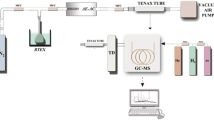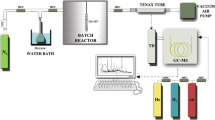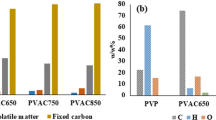Abstract
Benzene, toluene, ethylbenzene, and xylenes are commonly known as (BTEX) and include volatile organic compounds (VOCs) in ambient air. Exposure to some BTEX has been associated with health risks. This study aimed to reduce BTEX on the environment and human health dramatically. This research targeted decreasing the BTEX in an air environment by producing high surface area activated carbon (KA-AC) under optimized synthesis conditions from Ricinus communis as lignocellulosic waste using ZnCl2 solution, respectively. The influence of several activation parameters was investigated on the surface area, such as impregnation ratio, carbonization time, and carbonization temperature. The KA5-AC prepared under optimized conditions showed BET surface area and total pore volume of 1225 m2/g, and 0.72 cm3/g, respectively. The optimized synthesis conditions were as follows: 0.1, 0.5, 1, 2, and 5 M impregnation ratio, 450–950 °C carbonization temperature, and 100 min carbonization time. The characteristics of the optimized KA-AC were analyzed using nitrogen adsorption–desorption isotherm, scanning electron microscopy, and pore structural analysis. The results confirmed that the VOCs adsorption on KA-AC followed a monolayer adsorption isotherm over a homogeneous adsorbent surface. It showed the removal efficiency of benzene, toluene, ethylbenzene, and m, p-xylene (R2 = from 0.991 to 0.997). Moreover, the KA-AC exhibited good performance without considerable loss of efficacy throughout the experiments. Accordingly, it is concluded that developing low-cost activated carbon to use BTEX vapor adsorption research could be practical and developments to overcome for utilization in air pollution control.



Similar content being viewed by others
Data availability
The data will be provided by corresponding author under reasonable requests.
References
Aggarwal P, Jain S (2015) Impact of air pollutants from surface transport sources on human health: a modeling and epidemiological approach. Environ Int 83:146–157. https://doi.org/10.1016/j.envint.2015.06.010
Saxena P, Sonwani S (2019) Criteria air pollutants: chemistry, sources and sinks. Criteria air pollutants and their impact on environmental health. Springer, Singapore, pp 7–48
Guo H, Lee SC, Chan LY, Li WM (2004) Risk assessment of exposure to volatile organic compounds in different indoor environments. Environ Res 94(1):57–66. https://doi.org/10.1016/S0013-9351(03)00035-5
Liu Y, Shao M, Fu L, Lu S, Zeng L, Tang D (2008) Source profiles of volatile organic compounds (VOCs) measured in China: part I. Atmos Environ 42(25):6247–6260. https://doi.org/10.1016/j.atmosenv.2008.01.070
Zhang X, Gao B, Creamer AE, Cao C, Li Y (2017) Adsorption of VOCs onto engineered carbon materials: a review. J Hazard Mater 338:102–123. https://doi.org/10.1016/j.jhazmat.2017.05.013
Zhu L, Shen D, Luo KH (2020) A critical review on VOCs adsorption by different porous materials: species, mechanisms and modification methods. J Hazard Mater 389:122102. https://doi.org/10.1016/j.jhazmat.2020.122102
He Z, Li G, Chen J, Huang Y, An T, Zhang C (2015) Pollution characteristics and health risk assessment of volatile organic compounds emitted from different plastic solid waste recycling workshops. Environ Int 77:85–94. https://doi.org/10.1016/j.envint.2015.01.004
Bari MA, Kindzierski WB (2018) Ambient volatile organic compounds (VOCs) in Calgary, Alberta: sources and screening health risk assessment. Sci Total Environ 631:627–640. https://doi.org/10.1016/j.scitotenv.2018.03.023
Li L, Xie S, Zeng L, Wu R, Li J (2015) Characteristics of volatile organic compounds and their role in ground-level ozone formation in the Beijing-Tianjin-Hebei region, China. Atmos Environ 113:247–254. https://doi.org/10.1016/j.atmosenv.2015.05.021
Jenkin ME, Derwent RG, Wallington TJ (2017) Photochemical ozone creation potentials for volatile organic compounds: Rationalization and estimation. Atmos Environ 163:128–137. https://doi.org/10.1016/j.atmosenv.2017.05.024
He C, Cheng J, Zhang X, Douthwaite M, Pattisson S, Hao Z (2019) Recent advances in the catalytic oxidation of volatile organic compounds: a review based on pollutant sorts and sources. Chem Rev 119(7):4471–4568. https://doi.org/10.1021/acs.chemrev.8b00408
Chang CT, Chen BY (2008) Toxicity assessment of volatile organic compounds and polycyclic aromatic hydrocarbons in motorcycle exhaust. J Hazard Mater 153(3):1262–1269. https://doi.org/10.1016/j.jhazmat.2007.09.091
Atamaleki A, Motesaddi Zarandi S, Massoudinejad M, Samimi K, Fakhri Y, Ghorbanian M, Mousavi Khaneghah A (2021) The effect of frying process on the emission of the volatile organic compounds and monocyclic aromatic group (BTEX). Int J Environ Anal Chem. https://doi.org/10.1080/03067319.2021.1950148
Li AJ, Pal VK, Kannan K (2021) A review of environmental occurrence, toxicity, biotransformation and biomonitoring of volatile organic compounds. Environ Chem Ecotoxicol 3:91–116. https://doi.org/10.1016/j.enceco.2021.01.001
Niu H, Mo Z, Shao M, Lu S, Xie S (2016) Screening the emission sources of volatile organic compounds (VOCs) in China by multi-effects evaluation. Front Environ Sci Eng 10(5):1–11. https://doi.org/10.1007/s11783-016-0828-z
Helen GS, Liakoni E, Nardone N, Addo N, Jacob P, Benowitz NL (2020) Comparison of systemic exposure to toxic and/or carcinogenic volatile organic compounds (VOC) during vaping, smoking, and abstention. Cancer Prev Res 13(2):153–162. https://doi.org/10.1158/1940-6207.CAPR-19-0356
Simon V, Baer M, Torres L, Olivier S, Meybeck M, Della Massa JP (2004) The impact of reduction in the benzene limit value in gasoline on airborne benzene, toluene and xylenes levels. Sci Total Environ 334:177–183. https://doi.org/10.1016/j.scitotenv.2004.04.065
Wu H (2010) Correlations between the Rayleigh ratio and the wavelength for toluene and benzene. Chem Phys 367(1):44–47. https://doi.org/10.1016/j.chemphys.2009.10.019
Villanueva F, Notario A, Adame JA, Millán MC, Mabilia R, Albaladejo J (2013) A preliminary study on ambient levels of carbonyls, benzene, toluene and xylene in the south-west of the Iberian Peninsula (Huelva coast), Spain. Environ Technol 34(3):289–299. https://doi.org/10.1080/09593330.2012.692719
International Agency for Research on Cancer (2012) A review of human carcinogens. F. Chemical Agents and Related Occupations: IARC Monographs on the Evaluation of Carcinogenic Risks to Humans. https://monographs.iarc.fr/wp-content/uploads/2018/06/mono100F.pdf. Accessed 10 May 2022
Rushton L, Brown TP, Cherrie J, Fortunato L, Van Tongeren M, Hutchings SJ (2010) How much does benzene contribute to the overall burden of cancer due to occupation? Chem Biol Interact 184(1–2):290–292. https://doi.org/10.1016/j.cbi.2009.11.007
Werder EJ, Engel LS, Blair A, Kwok RK, McGrath JA, Sandler DP (2019) Blood BTEX levels and neurologic symptoms in Gulf states residents. Environ Res 175:100–107. https://doi.org/10.1016/j.envres.2019.05.004
Maleki R, Asadgol Z, Kermani M, Jonidi Jafari A, Arfaeinia H, Gholami M (2020) Monitoring BTEX compounds and asbestos fibers in the ambient air of Tehran, Iran: seasonal variations, spatial distribution, potential sources, and risk assessment. Int J Environ Anal Chem. https://doi.org/10.1080/03067319.2020.1781836
Santiago F, Alves G, Otero UB, Tabalipa MM, Scherrer LR, Kosyakova N, Liehr T (2014) Monitoring of gas station attendants exposure to benzene, toluene, xylene (BTX) using three-color chromosome painting. Mol Cytogenet 7(1):1–7. https://doi.org/10.1186/1755-8166-7-15
da Poça KS, Giardini I, Silva PVB, Geraldino BR, Bellomo A, Alves JA, Sarpa M (2021) Gasoline-station workers in Brazil: benzene exposure; genotoxic and immunotoxic effects. Mutat Res Genet Toxicol Environ Mutagenesis 865:503322. https://doi.org/10.1016/j.mrgentox.2021.503322
Elango N, Kasi V, Vembhu B, Poornima JG (2013) Chronic exposure to emissions from photocopiers in copy shops causes oxidative stress and systematic inflammation among photocopier operators in India. Environ Health 12(1):1–12. https://doi.org/10.1186/1476-069X-12-78
Senthong P, Wittayasilp S (2018) Measurements and health impacts of carbon black and BTEXs in photocopy centers. Arch Environ Occup Health 73(3):169–175. https://doi.org/10.1080/19338244.2017.1400940
Davis AY, Zhang Q, Wong JP, Weber RJ, Black MS (2019) Characterization of volatile organic compound emissions from consumer level material extrusion 3D printers. Build Environ 160:106209. https://doi.org/10.1016/j.buildenv.2019.106209
Kim KH, Pandey SK, Kabir E, Susaya J, Brown RJ (2011) The modern paradox of unregulated cooking activities and indoor air quality. J Hazard Mater 195:1–10. https://doi.org/10.1016/j.jhazmat.2011.08.037
Heshmati A, Ghadimi S, Khaneghah AM, Barba FJ, Lorenzo JM, Nazemi F, Fakhri Y (2018) Risk assessment of benzene in food samples of Iran’s market. Food Chem Toxicol 114:278–284. https://doi.org/10.1016/j.fct.2018.02.043
Hadei M, Hopke PK, Shahsavani A, Moradi M, Yarahmadi M, Emam B, Rastkari N (2018) Indoor concentrations of VOCs in beauty salons; association with cosmetic practices and health risk assessment. J Occup Med Toxicol 13(1):1–9. https://doi.org/10.1186/s12995-018-0213-x
Moradi M, Hopke P, Hadei M, Eslami A, Rastkari N, Naghdali Z, Shahsavani A (2019) Exposure to BTEX in beauty salons: biomonitoring, urinary excretion, clinical symptoms, and health risk assessments. Environ Monit Assess 191(5):1–10. https://doi.org/10.1007/s10661-019-7455-7
Mokammel A, Rostami R, Niazi S, Asgari A, Fazlzadeh M (2022) BTEX levels in rural households: heating system, building characteristic impacts and lifetime excess cancer risk assessment. Environ Pollut. https://doi.org/10.1016/j.envpol.2022.118845
Hopf NB, Kirkeleit J, Bråtveit M, Succop P, Talaska G, Moen BE (2012) Evaluation of exposure biomarkers in offshore workers exposed to low benzene and toluene concentrations. Int Arch Occup Environ Health 85(3):261–271. https://doi.org/10.1007/s00420-011-0664-1
Protano C, Andreoli R, Manini P, Guidotti M, Vitali M (2012) A tobacco-related carcinogen: assessing the impact of smoking behaviours of cohabitants on benzene exposure in children. Tob Control 21(3):325–329. https://doi.org/10.1136/tc.2010.039255
Fedoruk MJ, Kerger BD (2003) Measurement of volatile organic compounds inside automobiles. J Eposure Sci Environ Epidemiol 13(1):31–41. https://doi.org/10.1038/sj.jea.7500250
Badjagbo K, Loranger S, Moore S, Tardif R, Sauve S (2010) BTEX exposures among automobile mechanics and painters and their associated health risks. Hum Ecol Risk Assess Int J 16(2):301–316. https://doi.org/10.1080/10807031003670071
Jayawardhana Y, Mayakaduwa SS, Kumarathilaka P, Gamage S, Vithanage M (2019) Municipal solid waste-derived biochar for the removal of benzene from landfill leachate. Environ Geochem Health 41(4):1739–1753. https://doi.org/10.1007/s10653-017-9973-y
Dehghani M, Mohammadpour A, Abbasi A, Rostami I, Gharehchahi E, Derakhshan Z, Conti GO (2022) Health risks of inhalation exposure to BTEX in a municipal wastewater treatment plant in Middle East city: Shiraz, Iran. Environ Res. https://doi.org/10.1016/j.envres.2021.112155
Adebesin F, Widhalm JR, Boachon B, Lefèvre F, Pierman B, Lynch JH, Dudareva N (2017) Emission of volatile organic compounds from petunia flowers is facilitated by an ABC transporter. Science 356(6345):1386–1388. https://doi.org/10.1126/science.aan0826
Yu KP, Lee GWM, Huang WM, Wu CC, Lou CL, Yang S (2006) Effectiveness of photocatalytic filter for removing volatile organic compounds in the heating, ventilation, and air conditioning system. J Air Waste Manag Assoc 56(5):666–674. https://doi.org/10.1080/10473289.2006.10464482
Schnabel R, Fijten R, Smolinska A, Dallinga J, Boumans ML, Stobberingh E, van Schooten FJ (2015) Analysis of volatile organic compounds in exhaled breath to diagnose ventilator-associated pneumonia. Sci Rep 5(1):1–10. https://doi.org/10.1038/srep17179
Krugly E, Pitak O, Ciuzas D, Tichonovas M, Stasiulaitiene I, Urniezaite I, Martuzevicius D (2022) VOC removal from ventilation air by gas-to-particle conversion: towords the enhancement of process efficiency. Build Environ 209:108647. https://doi.org/10.1016/j.buildenv.2021.108647
Council Directive 96/62/EC, of 27 September 1996 On ambient air quality assessment and management (The Framework Directive). From the Official Journal of the European Communities, 21.11.1996, En Series, L296/55
Council Directive 1999/30/EC, of 22 April 1999. Relating to limit values for sulphur dioxide, nitrogen dioxide and oxides of nitrogen, particulate matter and lead in ambient air (The First Daughter Directive). From the Official Journal of the European Communities, 29.6.1999, En Series, L163/41
Council Directive 2000/69/EC 2000. Relating to Limit Values for Benzene and Carbon Monoxide in Ambient Air
Feng C, Khulbe KC, Tabe S (2012) Volatile organic compound removal by membrane gas stripping using electro-spun nanofiber membrane. Desalination 287:98–102. https://doi.org/10.1016/j.desal.2011.04.074
Zhou X, Moghaddam TB, Chen M, Wu S, Adhikari S (2020) Biochar removes volatile organic compounds generated from asphalt. Sci Total Environ 745:141096. https://doi.org/10.1016/j.scitotenv.2020.141096
Simpson IJ, Marrero JE, Batterman S, Meinardi S, Barletta B, Blake DR (2013) Air quality in the Industrial Heartland of Alberta, Canada and potential impacts on human health. Atmos Environ 81:702–709. https://doi.org/10.1016/j.atmosenv.2013.09.017
Soni V, Singh P, Shree V, Goel V (2018) Effects of VOCs on human health. In: Sharma N, Agarwal A, Eastwood P, Gupta T, Singh A (eds) Air pollution and control. Energy, environment, and sustainability. Springer, Singapore. https://doi.org/10.1007/978-981-10-7185-0_8
Iranpour R, Cox HH, Deshusses MA, Schroeder ED (2005) Literature review of air pollution control biofilters and biotrickling filters for odor and volatile organic compound removal. Environ Prog 24(3):254–267. https://doi.org/10.1002/ep.10077
Guieysse B, Hort C, Platel V, Munoz R, Ondarts M, Revah S (2008) Biological treatment of indoor air for VOC removal: potential and challenges. Biotechnol Adv 26(5):398–410. https://doi.org/10.1016/j.biotechadv.2008.03.005
Huang Y, Ho SSH, Lu Y, Niu R, Xu L, Cao J, Lee S (2016) Removal of indoor volatile organic compounds via photocatalytic oxidation: a short review and prospect. Molecules 21(1):56. https://doi.org/10.3390/molecules21010056
Yang C, Miao G, Pi Y, Xia Q, Wu J, Li Z, Xiao J (2019) Abatement of various types of VOCs by adsorption/catalytic oxidation: a review. Chem Eng J 370:1128–1153. https://doi.org/10.1016/j.cej.2019.03.232
Almaie S, Vatanpour V, Rasoulifard MH, Koyuncu I (2022) Volatile organic compounds (VOCs) removal by photocatalysts: Aa review. Chemosphere. https://doi.org/10.1016/j.chemosphere.2022.135655
Dobre T, Pârvulescu OC, Iavorschi G, Stroescu M, Stoica A (2014) Volatile organic compounds removal from gas streams by adsorption onto activated carbon. Ind Eng Chem Res 53(9):3622–3628. https://doi.org/10.1021/ie402504u
Gil ER, Ruiz B, Lozano MS, Martín MJ, Fuente E (2014) VOCs removal by adsorption onto activated carbons from biocollagenic wastes of vegetable tanning. Chem Eng J 245:80–88. https://doi.org/10.1016/j.cej.2014.02.012
Xiang W, Zhang X, Chen K, Fang J, He F, Hu X, Gao B (2020) Enhanced adsorption performance and governing mechanisms of ball-milled biochar for the removal of volatile organic compounds (VOCs). Chem Eng J 385:123842. https://doi.org/10.1016/j.cej.2019.123842
Isinkaralar K (2022) Theoretical removal study of gas BTEX onto activated carbon produced from Digitalis purpurea L. biomass. Biomass Convers Biorefinery. https://doi.org/10.1007/s13399-022-02558-2
Barrett EP, Joyner LG, Halenda PP (1951) The determination of pore volume and area distributions in porous substances. I. Computations from nitrogen isotherms. J Am Chem Soc 73(1):373–380. https://doi.org/10.1021/ja01145a126
Chatterjee S, Saito T (2015) Lignin-derived advanced carbon materials. Chemsuschem 8(23):3941–3958. https://doi.org/10.1002/cssc.201500692
Ponomarev N, Sillanpää M (2019) Combined chemical-templated activation of hydrolytic lignin for producing porous carbon. Ind Crops Prod 135:30–38. https://doi.org/10.1016/j.indcrop.2019.03.050
Gómez-Avilés A, Peñas-Garzón M, Belver C, Rodriguez JJ, Bedia J (2021) Equilibrium, kinetics and breakthrough curves of acetaminophen adsorption onto activated carbons from microwave-assisted FeCl3-activation of lignin. Sep Purif Technol 278:119654. https://doi.org/10.1016/j.seppur.2021.119654
Maneerung T, Liew J, Dai Y, Kawi S, Chong C, Wang CH (2016) Activated carbon derived from carbon residue from biomass gasification and its application for dye adsorption: kinetics, isotherms and thermodynamic studies. Biores Technol 200:350–359. https://doi.org/10.1016/j.biortech.2015.10.047
Ioannidou OA, Zabaniotou AA, Stavropoulos GG, Islam MA, Albanis TA (2010) Preparation of activated carbons from agricultural residues for pesticide adsorption. Chemosphere 80(11):1328–1336. https://doi.org/10.1016/j.chemosphere.2010.06.044
Vargas AM, Cazetta AL, Garcia CA, Moraes JC, Nogami EM, Lenzi E, Almeida VC (2011) Preparation and characterization of activated carbon from a new raw lignocellulosic material: Flamboyant (Delonix regia) pods. J Environ Manage 92(1):178–184. https://doi.org/10.1016/j.jenvman.2010.09.013
Nayak A, Bhushan B, Gupta V, Sharma P (2017) Chemically activated carbon from lignocellulosic wastes for heavy metal wastewater remediation: effect of activation conditions. J Colloid Interface Sci 493:228–240. https://doi.org/10.1016/j.jcis.2017.01.031
Santos-Clotas E, Cabrera-Codony A, Ruiz B, Fuente E, Martín MJ (2019) Sewage biogas efficient purification by means of lignocellulosic waste-based activated carbons. Biores Technol 275:207–215. https://doi.org/10.1016/j.biortech.2018.12.060
Piccin JS, Cadaval TRSA, Pinto LAAD, Dotto GL (2017) Adsorption isotherms in liquid phase: experimental, modeling, and interpretations. Adsorption processes for water treatment and purification. Springer, Cham, pp 19–51. https://doi.org/10.1007/978-3-319-58136-1_2
Sellaoui L, Saha BB, Wjihi S, Lamine AB (2017) Physicochemical parameters interpretation for adsorption equilibrium of ethanol on metal organic framework: application of the multilayer model with saturation. J Mol Liq 233:537–542. https://doi.org/10.1016/j.molliq.2016.07.017
Chiang YC, Chiang PC, Huang CP (2001) Effects of pore structure and temperature on VOC adsorption on activated carbon. Carbon 39(4):523–534. https://doi.org/10.1016/S0008-6223(00)00161-5
Jia L, Shi J, Long C, Lian F, Xing B (2020) VOCs adsorption on activated carbon with initial water vapor contents: adsorption mechanism and modified characteristic curves. Sci Total Environ 731:139184. https://doi.org/10.1016/j.scitotenv.2020.139184
Chen Q, Liu F, Mo J (2021) Vertical macro-channel modification of a flexible adsorption board with in-situ thermal regeneration for indoor gas purification to increase effective adsorption capacity. Environ Res 192:110218. https://doi.org/10.1016/j.envres.2020.110218
Gebreegziabher TB, Wang S, Nam H (2019) Adsorption of H2S, NH3 and TMA from indoor air using porous corncob activated carbon: Isotherm and kinetics study. J Environ Chem Eng 7(4):103234. https://doi.org/10.1016/j.jece.2019.103234
Isinkaralar K (2022) High-efficiency removal of benzene vapor using activated carbon from Althaea officinalis L. biomass as a lignocellulosic precursor. Environ Sci Pollut Res. https://doi.org/10.1007/s11356-022-20579-2
Sokhansanj A, Abdoli SM, Zabihi M (2020) Insight into simultaneous catalytic oxidation of benzene and toluene in air over the nano-catalyst: Experimental and modeling via CFD-ANN hybrid method. Process Saf Environ Prot 141:321–332. https://doi.org/10.1016/j.psep.2020.05.035
Liu R, Song H, Li B, Li X, Zhu T (2021) Simultaneous removal of toluene and styrene by non-thermal plasma-catalysis: Effect of VOCs interaction and system configuration. Chemosphere 263:127893. https://doi.org/10.1016/j.chemosphere.2020.127893
Liu Z, Adewuyi YG, Shi S, Chen H, Li Y, Liu D, Liu Y (2019) Removal of gaseous Hg0 using novel seaweed biomass-based activated carbon. Chem Eng J 366:41–49. https://doi.org/10.1016/j.cej.2019.02.025
Lin W, Xie X, Wang X, Wang Y, Segets D, Sun J (2018) Efficient adsorption and sustainable degradation of gaseous acetaldehyde and o-xylene using rGO-TiO2 photocatalyst. Chem Eng J 349:708–718. https://doi.org/10.1016/j.cej.2018.05.107
Ravenni G, Elhami OH, Ahrenfeldt J, Henriksen UB, Neubauer Y (2019) Adsorption and decomposition of tar model compounds over the surface of gasification char and active carbon within the temperature range 250–800° C. Appl Energy 241:139–151. https://doi.org/10.1016/j.apenergy.2019.03.032
Guo Y, Tan C, Sun J, Li W, Zhang J, Zhao C (2020) Porous activated carbons derived from waste sugarcane bagasse for CO2 adsorption. Chem Eng J 381:122736. https://doi.org/10.1016/j.cej.2019.122736
Ma X, Yang L, Wu H (2021) Removal of volatile organic compounds from the coal-fired flue gas by adsorption on activated carbon. J Clean Prod 302:126925. https://doi.org/10.1016/j.jclepro.2021.126925
Funding
There is no financial support and commercial support.
Author information
Authors and Affiliations
Contributions
KI: raw material collection, processing analysis, and interpretation; AT: materials, processing analysis and literature search.
Corresponding author
Ethics declarations
Conflict of interest
The author declares no competing interests.
Ethical approval
Not applicable.
Consent to publish
Not applicable.
Consent to participate
Not applicable.
Additional information
Publisher's Note
Springer Nature remains neutral with regard to jurisdictional claims in published maps and institutional affiliations.
Rights and permissions
Springer Nature or its licensor holds exclusive rights to this article under a publishing agreement with the author(s) or other rightsholder(s); author self-archiving of the accepted manuscript version of this article is solely governed by the terms of such publishing agreement and applicable law.
About this article
Cite this article
Isinkaralar, K., Turkyilmaz, A. Simultaneous adsorption of selected VOCs in the gas environment by low-cost adsorbent from Ricinus communis. Carbon Lett. 32, 1781–1789 (2022). https://doi.org/10.1007/s42823-022-00399-7
Received:
Revised:
Accepted:
Published:
Issue Date:
DOI: https://doi.org/10.1007/s42823-022-00399-7




